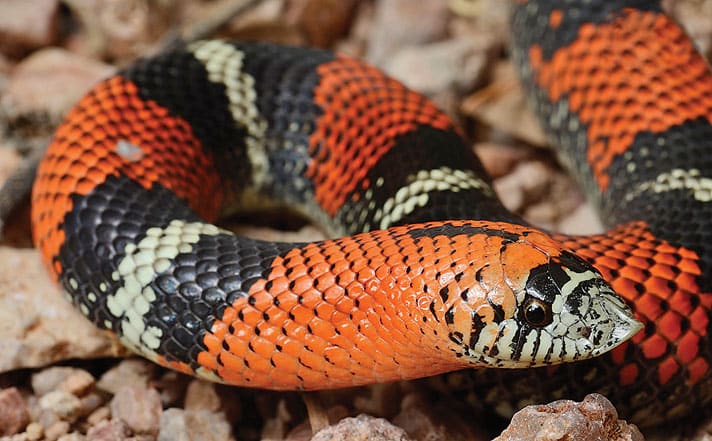Xenodon pulcher’s size and shape, color, personality, feeding response, and upturned hog nose, should contribute to a huge rise in popularity.
Wow, I never knew hognose snakes came in those bright colors! I want one!” It’s a typical reaction when people first lay eyes on our newest project’s progeny. I had to chuckle, though, because a misconception was fueling it, and the admirer was confusing the tricolor hognose (Xenodon pulcher) that he was looking at with the long-beloved western hognose snake (Heterodon nasicus).
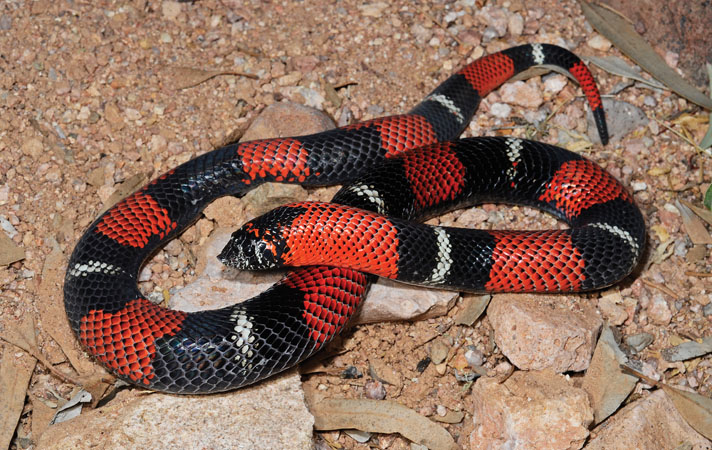
bill love
Comparative width of the tricolor hognose snake’s bands will be one beauty aspect for herpetocultural “artists” to refine in the years ahead.
There are currently 12 species in the genus Xenodon (formerly Lystrophis). The tricolor hognose, naturally found in southern South America, in parts of Brazil, Argentina, Paraguay and Bolivia, is the only species currently offered in the U.S., as far as I am aware. It has a spotty herpetocultural history in this country, and is only semi-successful at being embraced and propagated on a large or steady scale. The good news is that this is changing!
With this article, we hope to introduce readers to the wonderful X. pulcher, and alleviate any confusion between it and H. nasicus. Please note that I (Kathy) have done the actual writing, so the experiences described are my own, and although I’ve been raising baby tricolor hogs for about a year, all the in-depth breeding information contained herein is Roy’s via the extensive notes he has shared with me. All the tricolor hognose breeding that’s described was done at Roy’s facility, under his direction.
A Long-Time Quest For The Tricolor Hognose Snake
My first encounter with the tricolor hognose was back in the early 1990s, when we (my husband, Bill, and I) bought and sold a limited number of imported adults via Glades Herp, a Florida reptile breeding and importing business co-owned by us at the time. I was excited by the stout little critters with the pointy, upturned nose of a North American hognose and the colors of a typical milk snake. What could be more cool than that combination?
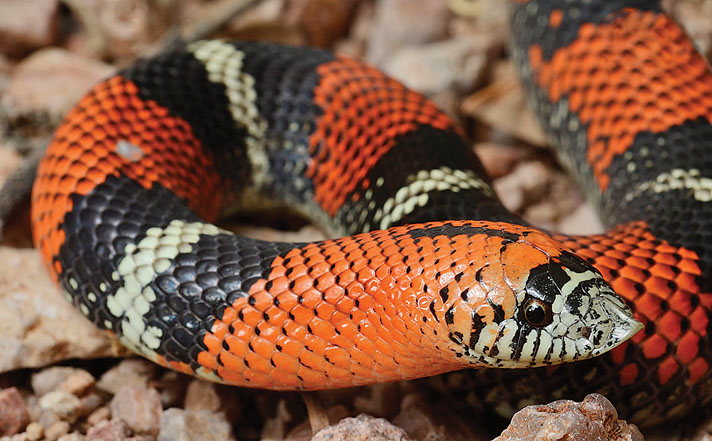
bill love
The sharp, upturned snout is a characteristic the South American tricolor hognose snake (Xenodon pulcher) shares with the more familiar Heterodon hognose snakes of North America.
Unfortunately, those imported adults turned out to be difficult to acclimate. Many refused to eat, and most customers reported that theirs eventually died without reproducing. By the early 2000s, only a few people in the U.S. were successfully keeping and breeding tricolor hognoses, and finding a captive-born baby to purchase was almost impossible.
I didn’t see the snakes offered again until around 2009, when I obtained a pair of Florida-bred babies. They thrived and grew quickly, but the male inexplicably developed spinal kinks as he matured. He survived for about six years, but the pair never produced fertile eggs.
By then, Europeans were producing larger numbers of tricolor hognoses, but they were still very difficult to find in the U.S. It wasn’t until 2014 when I finally acquired another adult pair, but lost the male soon after. With my original pair long gone and only one female left, my long-term quest to breed the tricolor hognose seemed doomed to failure.
Then, in early 2015, as Bill was preparing to embark on a road trip east from our home in Arizona, he remembered that Roy had some tricolor hognoses in west Texas. So I asked him to drop off my lone female with Roy on his way east. Due to previous breeding loan experiences, I half-thought that I would never see my female again, and that I would be better off looking for other projects. But, as luck would have it, loaning my female to Roy has led to my most successful joint-breeding project since I first began keeping snakes back in the 1960s!
Upon introduction, Roy’s male tricolor hognose immediately bred with my female, but her initial clutch of eggs were all infertile. Presumably, those eggs were already in development, and that first pairing came too late, but her next clutch was fertile, and so was the next — and the next, and the next!
We quickly discovered that tricolor hognose snakes are amazingly prolific once a healthy, compatible pair get together, and our wildly successful pair appears to have founded a whole new dynasty. We now want to share what we’ve learned to help readers start their own projects with these beauties.
Tricolor Hognose Snake Care
Adult tricolor hognoses usually average about 2 feet in length, with females usually slightly larger than males. They are more stout than a corn snake of similar length, but more slender than North American hognose snakes of the genus Heterodon.
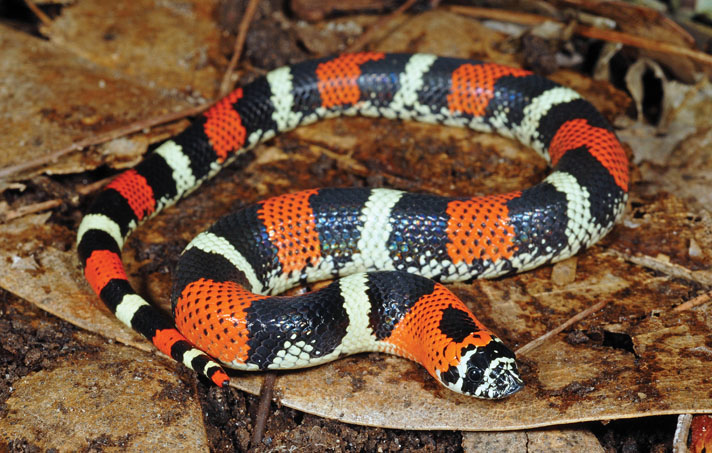
bill love
Captive-bred tricolor hognose babies have been available to the public in Europe for several years longer than in the U.S., but the total numbers produced are still small compared to other species of popular colubrid snakes.
Adults will need an enclosure that’s at least the size of a 10-gallon aquarium, but preferably more like a 20-gallon long aquarium that spans 30 inches. Because hognoses are terrestrial and fossorial (burrowing) snakes, the height of the enclosure is not as important as is adequate floor space.
Babies can start out in plastic shoeboxes measuring approximately 6 by 11 inches and 4 inches tall for the first year or so, though some of mine have outgrown these starter enclosures before their first birthdays.
My tricolors are usually curled up under the bedding, so it is important to provide a substrate in which they can hide completely, such as shredded aspen, cypress, or coco chips. Avoid pine or any substrate with a resinous odor to it.
Tricolor hogs need a moist place to hide, which can be provided by either dampening one end of the bedding, or providing a small hide box containing damp sphagnum moss. The rest of the cage can be left dry. In drier climates, I recommend using coco chips as a substrate because they can take added moisture without a fungal bloom resulting (as can happen with aspen shavings).
I’ve raised neonates with and without supplemental heating using cables/pads. My house is normally about 72 degrees Fahrenheit in winter and 78 in summer. The snakes have fed and done well at these temperatures, which seems to indicate tricolor hognoses are not particularly sensitive in this regard.
I have more recently used a heat cable, however, to raise the temperature on one end of their cages to about 82 degrees, providing a thermal gradient. The remainder of the cage stays close to the ambient room temperature. This is the end where the snakes spend the majority of their time, but a gradient is still preferable so they can choose the best temperatures and moisture levels for feeding, hiding, digestion and shedding.
I do not provide any supplemental lighting. Both Ray’s and my colonies are kept in rooms in which the snakes can sense the local photoperiod as it changes from month to month.
Feeding Tricolor Hognose Snakes
Most neonate tricolor hogs start out on frozen/thawed (f/t) pinkie mice. I start mine in deli cups containing nothing but the baby snake and its meal. Baby tricolors seem slightly shy about feeding while you watch, so I leave them alone and nearly always find the mouse is gone within an hour.
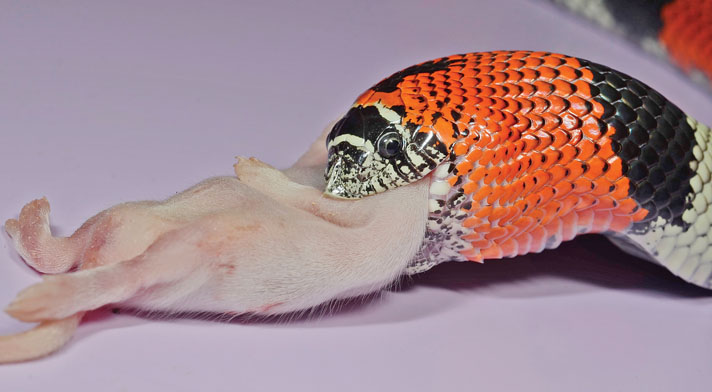
bill love
Because the head of Xenodon pulcher is so small, many underestimate the size of the meal it can consume. The neck is very stretchy, however, and the mid girth is big compared to many colubrids.
Young snakes usually work up to f/t adult mice by the time they are adults. The few that don’t start eating mice on their own can usually be prompted to do so by scenting mice with lizards (such as anoles) or toads.
Once tricolored hognose snakes are well-started, be sure to keep your fingers out of the way, as a tricolor hog’s feeding response can be frenzied. Adults may actually leap out of their cages, just like kingsnakes sometimes do when food is introduced! When in feeding mode, anything that moves is fair game.
Growing babies can be fed every four or five days, and adults about once per week.
Breeding Tricolor Hognose Snakes
Tricolor hognoses seem to be “live fast, die young” animals. We haven’t found anyone with specimens older than 8 years of age. To balance this seemingly negative aspect of a shorter life span, the snakes do grow very quickly and produce lots of eggs. Babies usually mature by 2 years of age, and possibly even sooner with aggressive feeding schedules. They typically hatch out at weights of 4 to 6 grams. Most hold-backs have weighed 20 to 35 grams at about 6 months, and 60 to 90 grams at 1 year of age. Females should be 200 grams or more before breeding.
Actively breeding females will need additional meals beyond the once-a-week schedule mentioned previously. They will eat almost constantly, and need as much food as they can get. Their tendency to produce consecutive clutches of eggs may wear females out if a frequent feeding regimen is not maintained during the warmer reproductive part of the year.
The most prolific females may produce four or five clutches of eggs per year. Eight clutches in a year is the most I have read about, but we discourage ours from laying more than five in one year because doing so, obviously, takes a lot out of the female.
Again, heavy feeding is paramount! And actively breeding females represent the most aggressive feeders. This is the definitely the time to keep your fingers out of their way!
Roy had two sexual pairs when my female was brought to him for breeding. She had been cycled the previous winter in a dark closet kept in the upper 50s Fahrenheit for two months without food prior to arriving inTexas. The previous winter Roy had kept his snakes somewhat cooler than their normal active summer temperatures, about 65 to 70 degrees, with photoperiods experienced through the windows.

bill love
My female bred in June 2015, laid bad eggs in July, then went on to lay three fertile clutches between September and November, with nine eggs in each clutch.
My female bred in June 2015, laid bad eggs in July, then went on to lay three fertile clutches between September and November, with nine eggs in each clutch.
The second half of 2015 was a great start to our joint project, and 2016 surpassed it. That year, my female and Roy’s younger female each produced five fertile clutches containing between six and nine eggs laid four to seven weeks apart.
The males were reintroduced after each clutch was laid, and the females were fed approximately every three days during this period. Their feeding response was so intense that they occasionally grabbed the males, and probably would have tried to eat them without intervention. We learned that reintroducing the males a day or two after the females had eaten a good-sized meal seemed to calm the females’ feeding aggression toward the males. At that time, the males usually started breeding immediately, or would run for their lives if the females were not receptive. Pairs were not left together unattended.
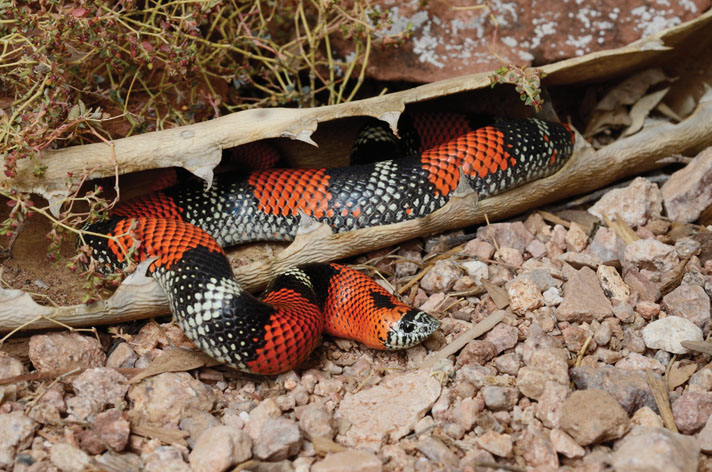
bill love
This fossorial species needs the security of hiding places in its enclosures, and several inches of substrate to burrow into to stay out of sight.
Females laid their eggs in small, plastic nest boxes lined with moist coconut fiber. The eggs were incubated in perlite, with approximately the same moisture level maintained for corns, kings, and other colubrids. The average room temperature was 78 degrees, with minor daily fluctuations between day and night temps.
No incubator was used because the room temperature where the eggs are kept is relatively constant. Incubation times ranged from 60 to 90 days, with an average of 70 days. Virtually all eggs that looked good at laying hatched. There have been a couple of sets of twins, too, which hatched out very small. Some babies fed and thrived, while others died without feeding.
After five clutches, the females were kept separated from the males and given a well-deserved rest and plenty of food. Although they were not weighed, they appeared to be none the worse for wear.
As of this writing, the adult tricolor hogs are being cooled down to 65 to 70 degrees from December through January, while experiencing shorter days through the windows. Occasional meals are offered and consumed a couple of times per month. After about two months they will be warmed up, and new pairings are planned for March 2017. By the time you’re reading this article, we’ll hopefully have new clutches on the way!
Tricolor Hognose Snake Handling And Temperament
Tricolor hogs not used to handling exhibit the same thrashing behavior I’ve noticed in milk snakes (Lampropeltis triangulum), as well as in eastern coral snakes (Micrurus fulvius). It makes me wonder if coral snake mimics, which tricolor hogs are considered to be by some observers, also mimic the spastic movements their venomous look-alikes exhibit. Such behavior would make it difficult for a predator to identify them precisely, leaving only the flash of red as a warning to leave it alone.
Though I have never heard of or witnessed tricolor hognoses playing dead, I have seen them flatten out the forepart of the body when threatened, as an intimidation behavior. This is similar to the behavior exhibited by North American hogs, but not as extreme.
Xenodon pulcher’s size and shape, in addition to its color, personality, feeding response, and upturned hog nose, should contribute to a huge rise in popularity once the species becomes more common.
People seem to like snakes that are compact and not too thin. Also, many hobbyists I’ve met at reptile expos want a pet snake that grows to only half the size of the corn snakes (Pantherophis guttatus) I usually offer. Corns never seemed particularly large to me, but tricolor hogs are the exact size that some herpers have been craving.
Even though tricolor hogs may thrash, none have tried to bite me unless I get my fingers in the way while they’re grabbing food. Unlike corn snakes, babies don’t seem to strike from defensive poses. They just bump and jerk, hoping you will drop them. Once they are habituated to gentle handling, however, the thrashing subsides or disappears altogether.
The tricolor hognose’s reluctance to bite is a great asset because it is rear-fanged and likely mildly venomous, like its North American counterpart. I haven’t read or heard of any accounts of envenomation effects due to a bite, and this doesn’t seem to be as much of a concern as may be for the several species of hognose snakes native to the U.S., some of which are known to produce bites that can result in swelling and soreness. Of course, prolonged chewing on the snake’s part doesn’t usually take place during the rare bites that do occur, which makes it hard to know potential toxicity.
The Future of Tricolor Hognose Snakes
Captive-bred tricolor hognose babies have been available to the public in Europe for several years longer than in the U.S., but the total numbers produced are still small compared to other species of popular colubrid snakes. Only small numbers have trickled over so far, adding to U.S. bloodlines.
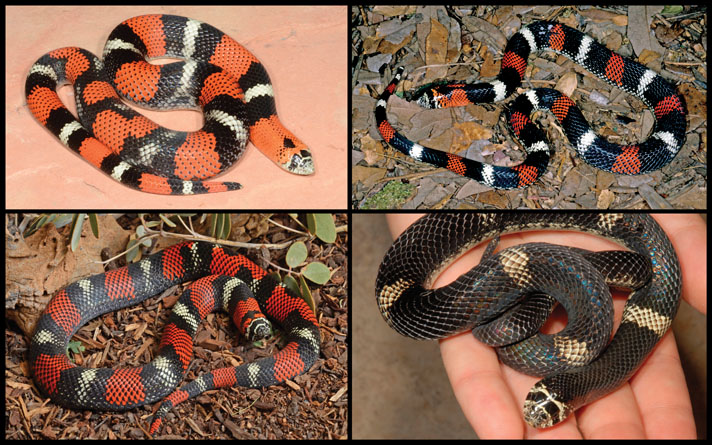
bill love
Much of the tricolor hognose’s allure lies in the snake’s natural variation. Some darken with age until they are virtually black, while many retain some or most of their juvenile brightness. Patterns range from symmetrical banding to various blotches and broken bands.
Selective breeding holds tremendous possibilities for X. pulcher, with the obvious goal of enhancing the species’ red and white bands being carried out with coming generations. Some offspring develop a considerable amount of black pigment that obscures the pattern, and this trait will certainly be selected against as breeders attempt to clean up and brighten the species’ colors.
Aberrant genes that are likely hiding in the genome have not yet surfaced. One European breeder has been offering hypoerythristic (exhibiting less than the normal amount of red pigmentation) babies, but I have not seen any other morphs on the market so far. That means there is still much to be discovered! The tricolor hognose’s already beautiful pattern and color variability, combined with its perfect size for hobbyists who prefer smaller snakes, bestows upon it the potential to be one of the “next big things“ in herpetoculture.
We’re excited about being in on the ground floor as the tricolor hognose snake finally becomes established in the hobby, and we’re proud our prolific females are helping to start an exciting new era for this hardy, attractive, yet still relatively unknown species of snake in herpetoculture.
Kathy Love has been breeding corn snakes and other reptiles since 1985. She and her husband, Bill Love, wrote Corn Snakes: The Comprehensive Owner’s Guide, the most complete corn snake book now available, which can be ordered through Kathy’s website at Cornutopia.com.
Roy Engeldorf has been keeping and breeding reptiles for over 40 years. He and his wife, Ruth, own and operate the Outback Oasis Motel in Sanderson, Tex. (outbackoasismotel.com).

